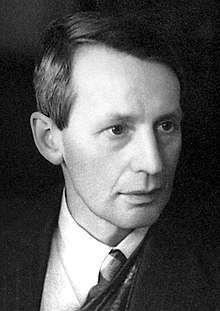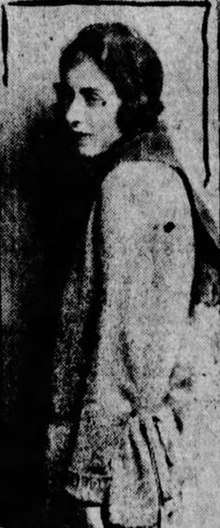George Paget Thomson
Sir George Paget Thomson, FRS[1] (/ˈtɒmsən/; 3 May 1892 – 10 September 1975) was an English physicist and Nobel laureate in physics recognized for his discovery of the wave properties of the electron by electron diffraction.[2][3][4]
Sir George Paget Thomson | |
|---|---|
 | |
| Born | 3 May 1892 Cambridge, England |
| Died | 10 September 1975 (aged 83) Cambridge, England |
| Nationality | British |
| Alma mater | Trinity College, Cambridge |
| Known for | Electron diffraction |
| Spouse(s) | Kathleen Buchanan Smith |
| Children | 2 sons, 2 daughters |
| Awards | Howard N. Potts Medal (1932) Nobel Prize in Physics (1937) Hughes Medal (1939) Royal Medal (1949) Faraday Medal (1960) |
| Scientific career | |
| Fields | Physics |
| Institutions | |
| Academic advisors | J. J. Thomson |
Education and early life
Thomson was born in Cambridge, England, the son of physicist and Nobel laureate J. J. Thomson and Rose Elisabeth Paget, daughter of George Edward Paget. Thomson went to The Perse School, Cambridge before going on to read mathematics and physics at Trinity College, Cambridge, until the outbreak of World War I in 1914, when he was commissioned into the Queen's Royal West Surrey Regiment. After brief service in France, he transferred to the Royal Flying Corps in 1915 doing research on aerodynamics at the Royal Aircraft Establishment at Farnborough and elsewhere. He resigned his commission as a Captain in 1920.
Career
After briefly serving in the First World War Thomson became a Fellow at Cambridge and then moved to the University of Aberdeen. George Thomson was jointly awarded the Nobel Prize for Physics in 1937 for his work in Aberdeen in discovering the wave-like properties of the electron. The prize was shared with Clinton Joseph Davisson who had made the same discovery independently. Whereas his father had seen the electron as a particle (and won his Nobel Prize in the process), Thomson demonstrated that it could be diffracted like a wave, a discovery proving the principle of wave–particle duality which had first been posited by Louis-Victor de Broglie in the 1920s as what is often dubbed the de Broglie hypothesis.
Between 1929–1930 Thomson was a Non-Resident Lecturer at Cornell University, Ithaca, New York.[3] In 1930 he was appointed Professor at Imperial College London in the chair of the late Hugh Longbourne Callendar. In the late 1930s and during the Second World War Thomson specialised in nuclear physics, concentrating on practical military applications. In particular Thomson was the chairman of the crucial MAUD Committee in 1940–1941 that concluded that an atomic bomb was feasible. In later life he continued this work on nuclear energy but also wrote works on aerodynamics and the value of science in society.
Thomson stayed at Imperial College until 1952, when he became Master of Corpus Christi College, Cambridge. In 1964, the college honored his tenure with the George Thomson Building, a work of modernist architecture on the college's Leckhampton campus.
Awards and honours
In addition to winning the Nobel Prize in Physics, Thomson was knighted in 1943. He gave the address "Two aspects of science" as president of the British Association for 1959–1960.[5]
Personal life

In 1924, Thomson married Kathleen Buchanan Smith, daughter of the Very Rev. Sir George Adam Smith. They had four children, two sons and two daughters. Kathleen died in 1941. Thomson died in 1975 and is buried with his wife in Granchester Parish Churchyard. One son, Sir John Thomson GCMG (1927–2018) became a senior diplomat who served as High Commissioner to India (1977–82) and Permanent Representative to the United Nations (1982–87), and his grandson Sir Adam Thomson KCMG (1955–present) also became a senior diplomat, serving as High Commissioner to Pakistan (2010–2013) and as Permanent Representative to NATO (2014–2016).
References
- Moon, P. B. (1977). "George Paget Thomson 3 May 1892 – 10 September 1975". Biographical Memoirs of Fellows of the Royal Society. 23: 529–556. doi:10.1098/rsbm.1977.0020.
- Thomson, G. P. (1927). "Diffraction of Cathode Rays by a Thin Film". Nature. 119 (3007): 890. Bibcode:1927Natur.119Q.890T. doi:10.1038/119890a0.
- "George Paget Thomson". Le Prix Nobel. the Nobel Foundation. 1937. Retrieved 12 September 2007.
- "Thomson, Sir George Paget". Encyclopædia Britannica. Encyclopædia Britannica, Inc. 2007. Retrieved 12 September 2007.
- Leake, Chauncey D. (14 October 1960). "Meeting: British Association for the Advancement of Science". Science. 132 (3433): 1023–1024. Bibcode:1960Sci...132.1023L. doi:10.1126/science.132.3433.1023. PMID 17820679.
External links
- Annotated Bibliography for George Paget Thomson from the Alsos Digital Library for Nuclear Issues
- Portraits of Sir George Paget Thomson at the National Portrait Gallery
- George Thomson biography at Wageningen University
- A history of the electron: JJ and GP Thomson published by the University of the Basque Country
| Academic offices | ||
|---|---|---|
| Preceded by Sir William Spens |
Master of Corpus Christi College, Cambridge 1952–1962 |
Succeeded by Sir Frank Godbould Lee |
